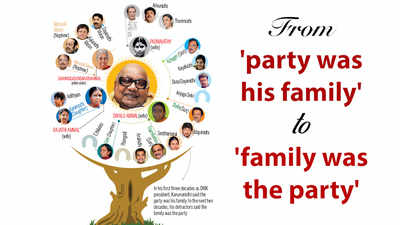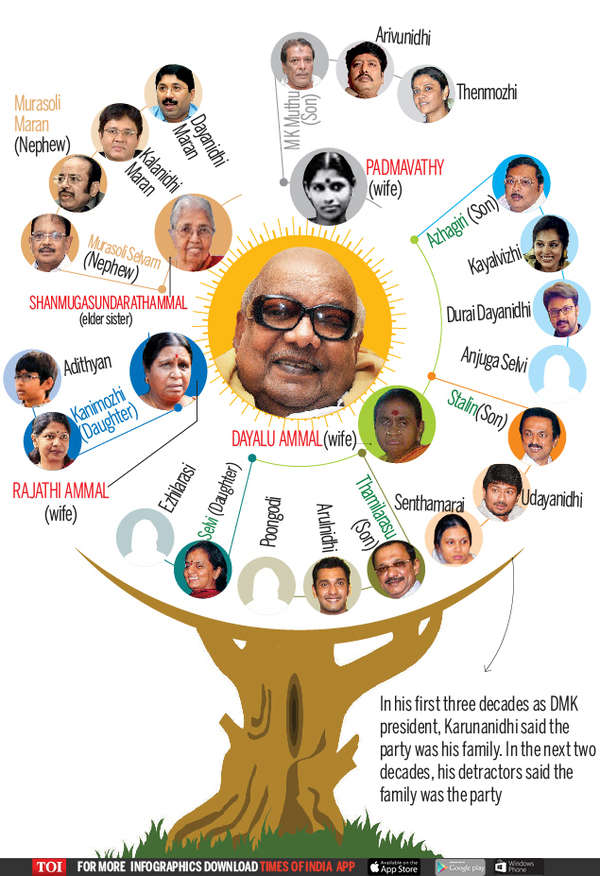- News
- City News
- chennai News
- Karunanidhi: A man who loved his family too much
Trending
This story is from August 8, 2018
Karunanidhi: A man who loved his family too much
For young Karunanidhi, who took the plunge into the Dravidian movement as a teenager, the movement came first, family next. Two more marriages and six children later, the leader was slowly growing into a patriarch. Soon after the turn of the 21st century, his love for the family was on full display — in the party and other power centres. This later gave Karunanidhi more than a headache.

Key Highlights
- The patriarch gave his relatives plum posts in the party, but later lived to feel the pain as some of them got stuck in prolonged judicial battles.
- In his first three decades as DMK president, Karunanidhi said the party was his family.
- In the next two decades, his detractors said the family was the party. By 2009, several family members occupied important posts in the party and the Union govt.
On a September day in 1944, while a 20-year-old groom was waiting for his bride, an anti-Hindi rally passed by. “Long live Tamil, down with Hindi,” shouted M Karunanidhi, the groom, and joined the protesters. The bride, Padmavathi, daughter of singer Sundaranar of Chidambaram, had to wait for more than an hour before some relatives brought Karunanidhi back to tie the knot.
For young Karunanidhi, who took the plunge into the Dravidian movement as a teenager, the movement came first, family next. Two more marriages and six children later, the leader was slowly growing into a patriarch. Soon after the turn of the 21st century, his love for the family was on full display — in the party and other power centres. This later gave Karunanidhi more than a headache.

In his first three decades as DMK president, Karunanidhi said the party was his family. In the next two decades, his detractors said the family was the party. By 2009, several family members occupied important posts in the party and the Union government. M K Stalin remained the chief minister-in-waiting, while his elder brother M K Alagiri became Union minister for chemicals and fertilizers, and daughter Kanimozhi was a Rajya Sabha member. Karunanidhi’s grandnephew Dayanidhi Maran was Union IT and telecommunications minister.
Political dynasties have ruled the roost in Indian politics, right from the Nehru-Gandhi family at the Centre, the Abdullahs in Kashmir, the Badals in Punjab and the Karunakaran family in Kerala. But none probably matched the Karunanidhi tribe in terms of size and influence.
Nobody in the party or outside accuses Karunanidhi of nepotism when it comes to Stalin, who followed in his father’s footsteps right from his student days. Being Karunanidhi’s son must have helped Stalin become a member of the DMK general committee at the age of 20, but he worked his way up. The Emergency, during which he was arrested and tortured by police, gave Stalin the much-needed political boost.
Chief minister Karunanidhi kept Stalin out of his cabinet in 1989 and 1996 though the son was an MLA. Probably he wanted Stalin to learn the ropes slowly and systematically. After all, there was no threat to the younger son’s eventual ascension; Vaiko, the rising star in the DMK, was forced out in 1993. The only other rebellion came from within the family, but Alagiri proved to be just sound and fury.
Watch: Three wives, six children - Did Karunanidhi's family become the party?
Karunanidhi had shown his paternal concern early. Realising the potential of cinema as a vehicle to politics, Karunanidhi made a vain attempt in the 1970s to launch his eldest son M K Muthu as a rival to MGR who was winning hearts as much on the silver screen as in the dustbowls of Tamil Nadu. Muthu proved to be a decent singer and terrible actor. He bombed.
Karunanidhi loved his nephew Murasoli Maran as much as his sons. It was this special relationship that prompted the DMK leader to make Maran’s younger son Dayanidhi a minister at the Centre in 2004 and 2009. Dayanidhi remains in legal tangles including the ‘telephone exchange case’ and the ‘Aircel-Maxis case’.
Against the backdrop of the 2G spectrum case and Radia tapes that featured the names of Stalin, Kanimozhi, Alagiri, Dayalu Ammal and Rajathi Ammal, the late political commentator Cho Ramaswamy told TOI in November 2010 that he was convinced that Karunanidhi was one of the most loving fathers he knew. “But his biggest mistake was introducing so many of his family members in politics,” he had said. “He became a puppet, and there were too many puppeteers.”
Karunanidhi took criticisms of nepotism in his stride, but felt the pain when Kanimozhi went to jail and investigators wanted to question an ailing Dayalu Ammal.
Around the same time, in November 2010, DMK ideologue the late Chinna Kuthoosi told TOI that Karunanidhi knew that promoting too many family members would be bad for the party, but he probably had his compulsions. “As long as Karunanidhi is alive,” he had said, “there will be no problem.”
For young Karunanidhi, who took the plunge into the Dravidian movement as a teenager, the movement came first, family next. Two more marriages and six children later, the leader was slowly growing into a patriarch. Soon after the turn of the 21st century, his love for the family was on full display — in the party and other power centres. This later gave Karunanidhi more than a headache.

In his first three decades as DMK president, Karunanidhi said the party was his family. In the next two decades, his detractors said the family was the party. By 2009, several family members occupied important posts in the party and the Union government. M K Stalin remained the chief minister-in-waiting, while his elder brother M K Alagiri became Union minister for chemicals and fertilizers, and daughter Kanimozhi was a Rajya Sabha member. Karunanidhi’s grandnephew Dayanidhi Maran was Union IT and telecommunications minister.
Political dynasties have ruled the roost in Indian politics, right from the Nehru-Gandhi family at the Centre, the Abdullahs in Kashmir, the Badals in Punjab and the Karunakaran family in Kerala. But none probably matched the Karunanidhi tribe in terms of size and influence.
Nobody in the party or outside accuses Karunanidhi of nepotism when it comes to Stalin, who followed in his father’s footsteps right from his student days. Being Karunanidhi’s son must have helped Stalin become a member of the DMK general committee at the age of 20, but he worked his way up. The Emergency, during which he was arrested and tortured by police, gave Stalin the much-needed political boost.
Chief minister Karunanidhi kept Stalin out of his cabinet in 1989 and 1996 though the son was an MLA. Probably he wanted Stalin to learn the ropes slowly and systematically. After all, there was no threat to the younger son’s eventual ascension; Vaiko, the rising star in the DMK, was forced out in 1993. The only other rebellion came from within the family, but Alagiri proved to be just sound and fury.
Karunanidhi's family - 3 wives, 6 children - and love on full display
Karunanidhi had shown his paternal concern early. Realising the potential of cinema as a vehicle to politics, Karunanidhi made a vain attempt in the 1970s to launch his eldest son M K Muthu as a rival to MGR who was winning hearts as much on the silver screen as in the dustbowls of Tamil Nadu. Muthu proved to be a decent singer and terrible actor. He bombed.
Karunanidhi loved his nephew Murasoli Maran as much as his sons. It was this special relationship that prompted the DMK leader to make Maran’s younger son Dayanidhi a minister at the Centre in 2004 and 2009. Dayanidhi remains in legal tangles including the ‘telephone exchange case’ and the ‘Aircel-Maxis case’.
Against the backdrop of the 2G spectrum case and Radia tapes that featured the names of Stalin, Kanimozhi, Alagiri, Dayalu Ammal and Rajathi Ammal, the late political commentator Cho Ramaswamy told TOI in November 2010 that he was convinced that Karunanidhi was one of the most loving fathers he knew. “But his biggest mistake was introducing so many of his family members in politics,” he had said. “He became a puppet, and there were too many puppeteers.”
Karunanidhi took criticisms of nepotism in his stride, but felt the pain when Kanimozhi went to jail and investigators wanted to question an ailing Dayalu Ammal.
Around the same time, in November 2010, DMK ideologue the late Chinna Kuthoosi told TOI that Karunanidhi knew that promoting too many family members would be bad for the party, but he probably had his compulsions. “As long as Karunanidhi is alive,” he had said, “there will be no problem.”
End of Article
FOLLOW US ON SOCIAL MEDIA










